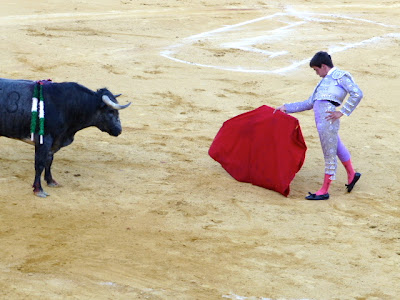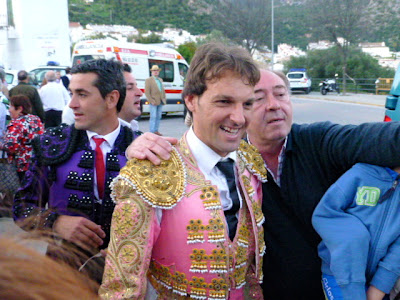 |
| Beautiful setting of bullring in Ubrique |
Last Saturday we were in Ubrique for a Corrida de Toros, or bullfight. I acknowledge again that bullfighting is controversial and I can understand why. While here in the sixties we went to a bunch of bullfights and have always found them exciting and fascinating to watch.
What I want to do here is describe an afternoon of bullfighting. I will use photos to depict different phases of the fight and try to explain what is happening. Let me refer you to the April 9 post "Bullfight in Villaluenga del Rosario" for some history and philosophy of the spectacle. In this post I will be doing more of a blow by blow as it were, describing the action. The phases of the bullfight follow a definite protocol.
Most bullfights begin late in the afternoon, usually 5:00 or 6:00. Ticket prices vary according to position relating to the ring itself and sol o sombra (sun or shade). Around noon before the fight six bulls (between four and six years old and weighing no less than 460 kilograms - 1014 lbs.) are selected from the group sent from the ganaderia (farm that raises bulls). Two bulls are chosen for each of three toreros (bullfighters). Each bullfighter fights two bulls. Each bullfighter has six assistants: two picadores, (lancers on horseback), three banderilleros, who, along with the lead bullfighter are also called toreros. The term matador refers to the main man and is mostly used when being described in English. The last member of the assistants is the mozo de espadas ( sword page). Collectively this group of men comprise a cuadrilla (entourage).
The modern corrida is highly ritualized, with three distinct stages or tercios (thirds). The afternoon begins with the participants entering the ring in the paseillo (parade), accompanied by a live band, seated in the stands, playing traditional music. The toreros wear the traditional traje de luces (suit of lights) which are quite ornate and beautiful.
In the first tercio the bull enters the ring and is tested by the toreros using the magenta and yellow capote (cape). A series of passes are done to observe the behavior and quirks of the bull.
 |
| Waiting for bull to be released |
Next, a picador enters on horseback and lances the bull in the neck which causes the bull to hold his head and horns slightly lower which enables the matador in his later cape work. The bull, because of the lancing, becomes more focused.
 |
| Protective boot worn by picador |
In the next stage, the tercio de banderillas (the third of banderillas), each of the banderilleros attempts to place two bandillerios (barbed sticks) into the bull's shoulders. These anger and agitate, as well as slightly weaken the bull. This is quite exciting because the banderillero is running at the charging bull and must lunge over the horns to place the banderillas.
In the final stage, the tercio de muerte (the third of death), the matador re-enters the ring alone with the muleta (small red cape) and sword. The matador uses his cape to attract the bull in a series of passes which serve the dual purpose of wearing down the bull for the kill and producing a beautful display or faena. The performance is broken down into a series of passes which highlights the skill and courage of the matador. When performed well by a skilled matador, this is the most exciting and beautiful part of the bullfight, almost seeming like a ballet.
This series of passes maneuvers the bull into a position where the matador can thrust the estocada (sword) between the shoulder blades of the bull and through the aorta, thus killing the bull.
After the bull has died he is taken from the ring and distributed for sale in butchers' shops or a local market.
If the matador has done a particularly good job and the fans are excited and impressed by his skill and grace, they petition the president of the fight to award a trophy - one ear for really good, two ears for terrific, and, rarely, two ears and a tail if the matador has performed in an exceptional manner.
 |
| Person in white shirt lower center has hung a white handkerchief over the rail to signify awarding of an ear. |
The cuadrilla then struts around the ring to receive adoration from the crowd.
At the end of the day the triumphant matadors are carried from the bullring on the shoulders of their fans. Mingling with the crowd adds to their popularity.
Controversial or not, we do enjoy la corrida de toros and will continue to attend when we can.
If you would like more detailed information on bullfighting you can go to the following sites online:
An excellent, some say the best, in-depth analysis of bullfighting is found in Death in the Afternoon by Ernest Hemingway.








































No comments:
Post a Comment